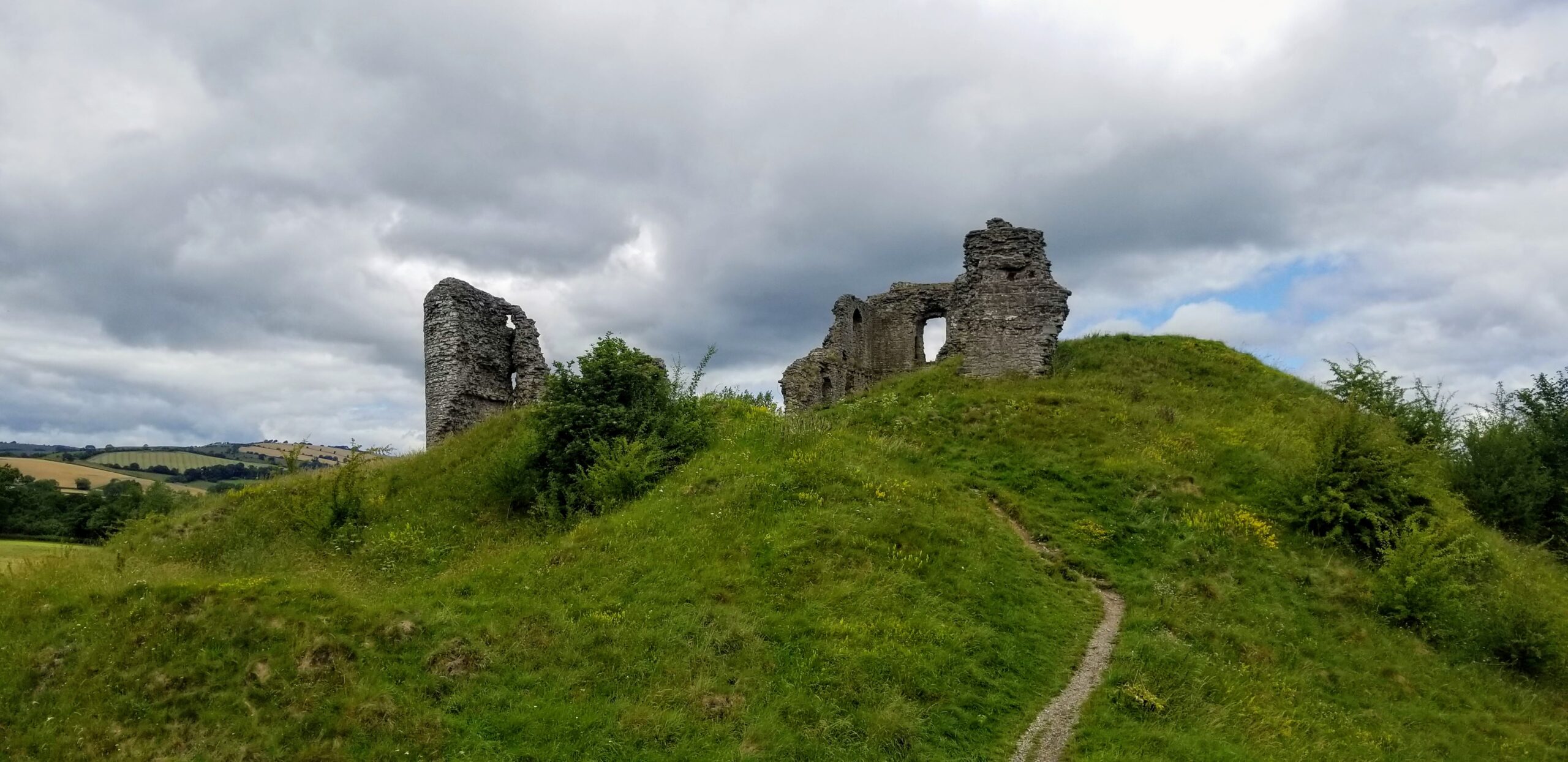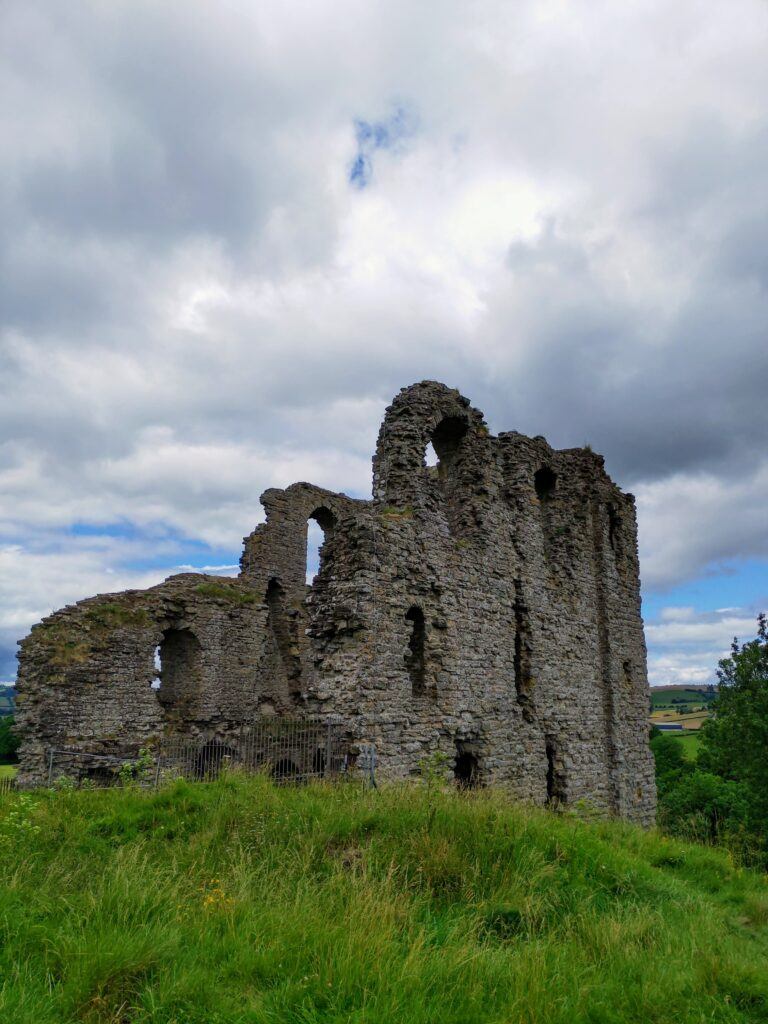Clun Castle is a Marcher Castle on the border of Wales and England, the castle is situated on a natural rocky mound in the small rural town of Clun overlooking the River Clun. The castle consists of a motte and three baileys and it has a very rare feature, it’s 13th century keep is set upon the sloping side of the motte rather than on top.
| Built | 11th Century |
| Type | Motte-and-Bailey |
| Condition | Ruin – Some Major stonework remains |
| Ownership | Private – Managed by English Heritage |
| Access | Public – Free |
Marcher Lord
Clun Castle was first built by the Norman Robert de Say (also known as Picot de Say), as part of the larger Marcher lordship known as the Honour of Clun. Following the Norman invasion in 1066 tensions were high along the Anglo-Welsh border, this led William the Conqueror granting lands to his most trusted men. These men became the Marcher Lords, they had the right to build castles and rule their lands as they saw fit, but still owed allegiance to the monarch. Clun castle was built in the late 11th century as a timber motte and bailey castle, with two baileys, though the structure was replaced with stone soon after.
Under Attack
The powerful Fitzalan family became the lords of Clun Castle in the mid 12th century, when William Fitzalan of Oswestry married Isabella de Say. Around this time a new town began to emerge next to the castle in a typical grid pattern, this layout is still visible today in Clun town.
In 1196, Prince Rhys of South Wales attacked the castle and burnt it down, although it was quickly rebuilt. In 1199 the castle passed to William and Isabella’s son, also named William Fitzalan. William died in 1210 and the castle passed to his son, but King John demanded a colossal 10,000 Marks for William to inherit the castle. William was unable to pay and died soon afterwards. William’s brother, John Fitzalan joined the First Barons’ War (1215–1217) and reclaimed the castle. Naturally, King John did not take this lightly and sent troops to besiege Clun Castle. King John died before the end of the war and John Fitzalan made peace with King Henry III in 1217, though he still had to pay the 10,000 Marks.
In 1233 the castle was besieged again, this time by Prince Llywelyn of Wales (Llywelyn the Great) who had battled many Marcher lords. Clun Castle successfully resisted the attack but the local town was destroyed.
Quieter Times
After Edward I’s invasion of Wales in 1280 the threat of attack from the Welsh dramatically reduced. In approximately 1292, Richard Fitzalan built the unusual great keep that stands on the sloping side of the motte instead of on top of it. The keep was four stories high and reached 80 feet, but was likely built more for comfort than defence which is evidenced in the lack of arrow slits.
Fading
The Fitzalen family had acquired Arundel Castle through marriage in 1243 and moved their main residence there, Clun Castle was now used for administrative purposes and as a hunting lodge.
Clun Castle was hastily refortified in the early 15th century during the Welsh Revolt (1400-1415) led by Owain Glyndwr. Following this attack it seems the castle was disused as there’s very little mention of it and by the mid 16th century it was ruinous. Although the castle was completely abandoned and not involved in the English Civil War (1642–1651), it still did not escape being slighted (deliberately destroyed) by Parliament.
Modern Times
Clun Castle is now a Grade I listed building and Scheduled Monument. It is owned by the Duke of Norfolk and managed by English Heritage. The castle ruins are open to the public free of charge.
The remains of the great keep are still impressive on the side of the motte. On the top of the motte there are remains of a wall that is thought to have been a smaller square keep from the 12th century. There are also some remains of the bridge, foundations of two turrets and the walls of two baileys.
Address: Newport St, Clun, Shropshire, SY7 8JT
Location: Latitude 52.422083 Longitude -3.033029





Oh that poor castle. Is there anyone that has not tried to destroy it over the years? However, your article is a testament to its longevity. All these years later it is still standing and still attracting people to venture inside its walls. It looks like a fascinating place to visit. I love finding things that are off the beaten track, where I walk my dog, enjoy some local history and just escape for a day and this looks like a nice place to visit. To be honest, from the first photo I thought it was just a pile of stones so I am glad I continued reading and came across the next few photos. It was nice to be taken back in time for a while, so thank you. Next time I am down that way I am definitely going to set it on my sat nav and have a look around.
It is indeed a lovely place and is located in the centre of a rather picturesque small town (also called Clun). It is completely free to explore with delightful views.
I have always thought that castles are fictional and are only found in cartoons. I did not know that they actually exist. These are the places I have definitely added on my bucket list and I would like to visit before I die. I need to see a castle in real life. The clun castle looks like a great place to start.
Castles are very real and vary tremendously in size, condition, age and so on. I will be adding many more wonderful castle’s to the site so keep an eye out and I hope you get to visit one soon!
I love visiting castles. My family is in Germany, and I have been to a lot of castles in Europe. They are amazing and beautiful and so full of history. Just as this one is. I think it would be a lot of fun to see castles from other areas than just Europe. I would even love to stay in one!